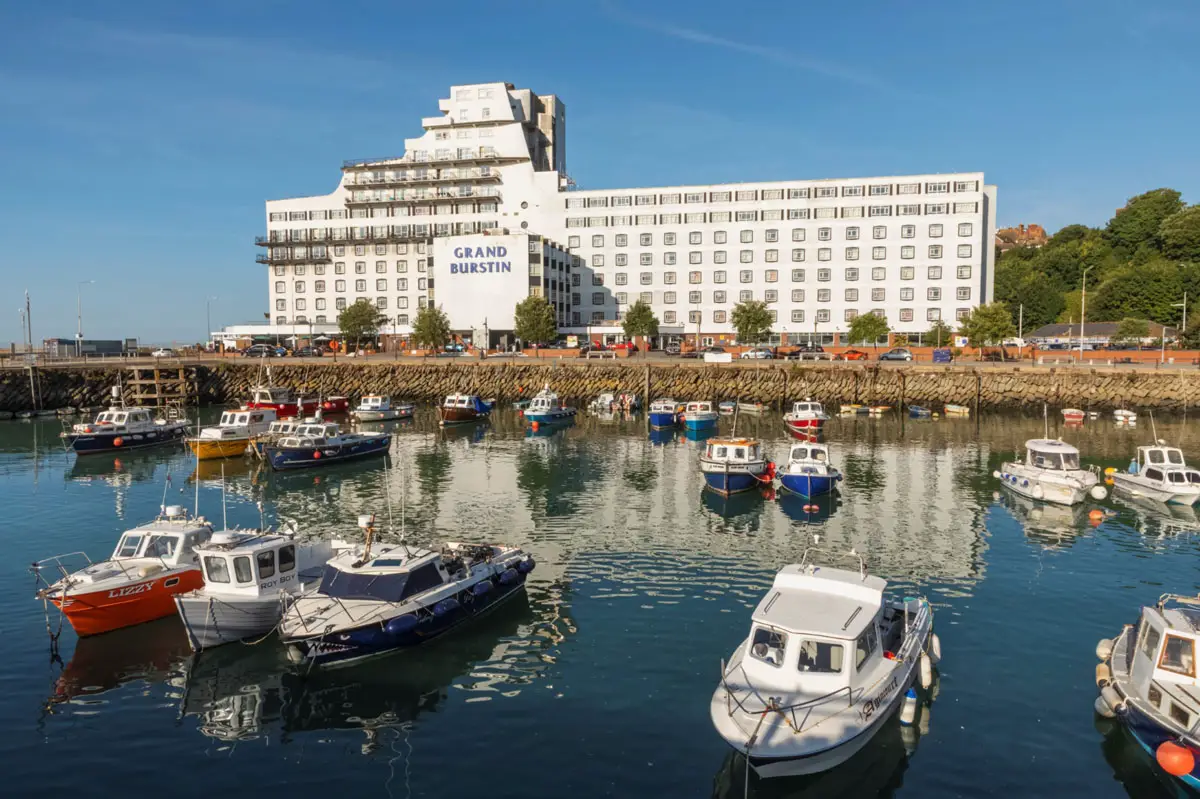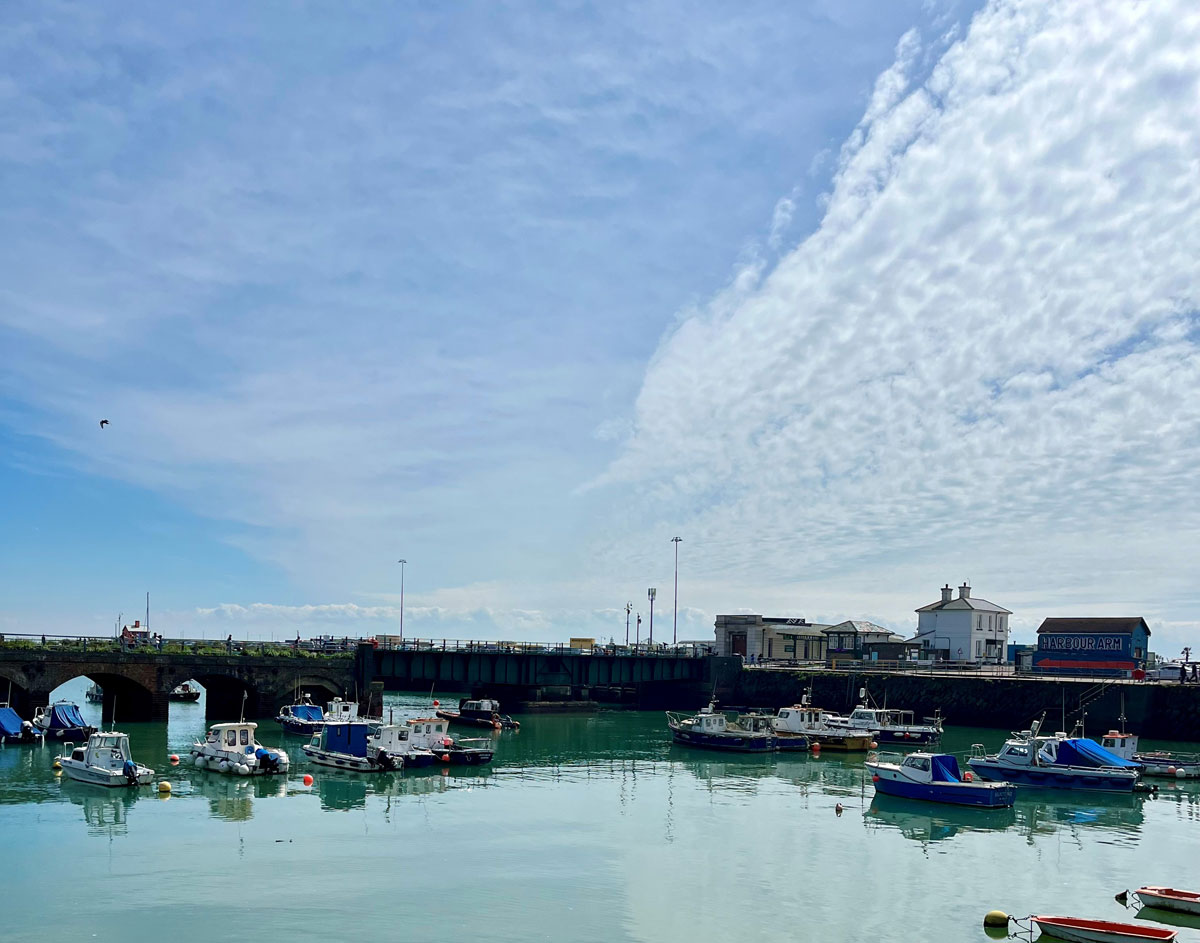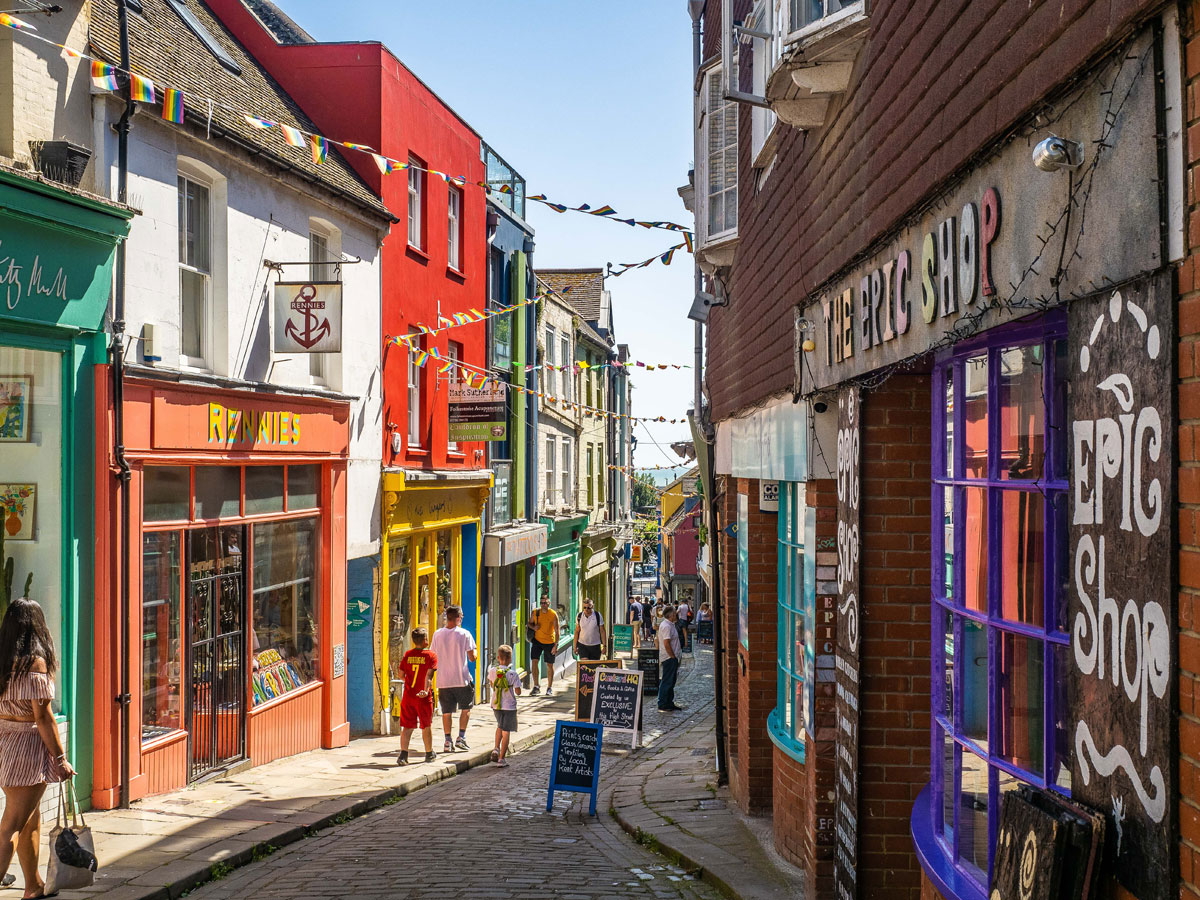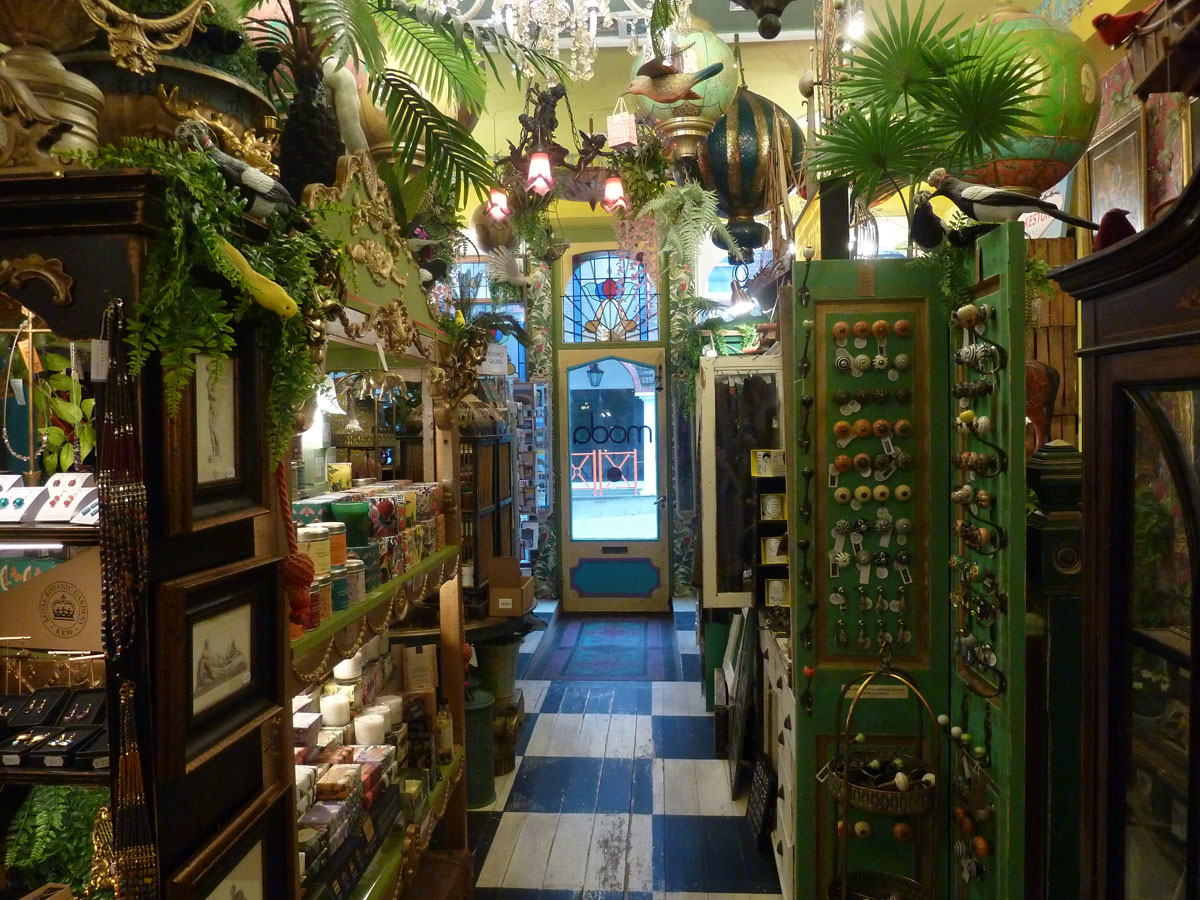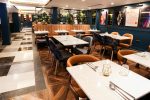Folkestone, Hastings & the Grand Burstin Hotel – Travel Review

By Clare Jenkins, June 2024
Half a mile out of Hastings town centre, we suddenly found ourselves in India. Or, at least, in British Raj-era India.
Hastings Art Gallery’s magnificent two-tiered Durbar Hall is all dark brown teak and Himalayan cedar, Moghul-style arches, screens and balconies, lit by golden stained-glass windows and a lantern roof. Built for the 1886 Indian and Colonial exhibition and intricately carved by two Punjabi craftsmen who came over to London specially, it was designed to replicate part of an Indian Palace. The then Prince of Wales – later Edward VII – used the top floor as a reception area.
After the exhibition, it was bought by Liberal politician Lord Brassey to use as a smoking room and museum in his home in London’s Park Lane. After his death in 1918, his son donated the whole hall to Hastings. And what a treat it is, with its stunning carvings, both floral and abstract, animal and human (including the odd finely moustachioed head).
“A world away”
The top floor is full of artefacts from India, Japan, South Africa, and from Lady Brassey’s extensive ethnographic collection… The tooth of a sperm whale, pottery from Fiji and ancient Rome, clay and plaster models showing chapati-makers and fruit sellers from Lucknow, a wooden model of a mosque ‘presented to the Countess of Willingdon in 1935’, a 17th Century Japanese suit of armour complete with swords, a 19th Century Tantric Buddha figure, a snake charmer’s pipe from Sri Lanka…
It’s a world away from Hastings itself, which we had little time to explore beyond spotting blue plaques to pioneering women on a fine crescent of handsome seafront-facing town houses, now sadly decayed and divided into flats. Barbara Leigh Smith Bodichon (1827-91) was a ‘pioneering campaigner for women’s rights, and artist’. Muriel Matters-Porter (1877-1969), was the first woman to speak in the House of Commons. Who knew?
We were in Hastings thanks to a Just Go! coach holiday exploring Kent’s ‘charming coast’ and based at Folkestone’s 1980s much-debated hotel, the Grand Burstin. Built to resemble a cruise ship and now part of the Britannia group, it’s very much a Marmite hotel: you either love it or – like many TripAdvisor reviewers – hate it.
“Sea-facing”
First impressions weren’t altogether encouraging. With the entrance encased by scaffolding, we were shepherded into a basement function room for our ‘welcome talk’ while Culture Club’s ‘Karma Chameleon’ belted out from the speakers. In the event, though, most of us were allocated clean and comfortable seafront-facing rooms with mesmerising views.
According to sales manager Gisele Buckingham, the hotel – with its 550 bedrooms, Ocean Ballroom, Spindles health and leisure club and various lounges – is popular with the over-50s and families. Hence the ‘Ceroc escape weekenders’ for dance fans, the tribute bands, the 1960s Hermans Hermits/Swinging Blue Jeans/Edison Lighthouse events, the tea-dancing Tuesdays – and the Beach Boys music playing in the corridors.
Buffet dinners (including good vegetarian options) were served in the large, sea-facing Harbour Restaurant. Its high ceiling, gilded bosses, crimson and gold floor-to-ceiling curtains and chandeliers reflected its previous life as part of the mid-Victorian Royal Pavilion Hotel, now mostly demolished.
“Bohemianised”
The harbour itself – a major embarkation point for British troops heading to France and the Western Front during World War One – was being developed, so sections looked like a building site. But the disused railway line directly outside the hotel has been bohemianised, with bars and cafes, pretty flower boxes, a walkway and signs in French: ‘Renseignements, telegraphes…’
There used to be four railway lines in this important Channel port-cum-UK departure point for Boulogne and the Venice Simplon Orient Express. Now, there’s just one, though it does provide a High Speed link to London.
Despite being recently named the best place to live in the south-east by the Sunday Times – who called it ‘the very model of modern regeneration for shipshape and stylish living’ – Folkestone didn’t exactly look its best in a chilly March.
Like many seaside towns, it’s a mishmash of Victorian and Edwardian villas, undistinguished 1950s and 60s estates (the port was heavily bombed during the last war), run-down 1970s flats and institutional buildings. Even the local Conservative Party HQ looked dingey and neglected.
“Striking”
However, the part-cobbled main streets in the Creative Quarter leading from the harbour are striking, with vintage lamp-posts and characterful old buildings painted cherry red, lilac, orange and sky-blue. Many house independent cafes and shops, among them the delightful Mode Emporium, with its Oriental souk-like interior and tempting collection of gifts, artwork, candles and silk kimonos.
Along the rather ramshackle Tontine Street, a neon-lit sign proclaimed ‘Heaven is a place where nothing ever happens’ over the parakeet-green-painted Old Post Office. Both Tontine Street and the Old High Street are lined with art and ceramic studios and vintage clothing shops.
Blue signs outside many of the buildings trace their history and previous inhabitants: William R Wellard, ‘piano dealer and hairdresser’ (1891); Henry Webber, ‘baker and confectioner who lived above the shop with his wife Florence and their children Ethel and Maud’. Webber’s is now Folkestone Wholefoods, selling knitted socks and joss sticks along with gluten-free muesli, CBD gel and Kentish Kombucha – ‘’the original probiotic energy drink’. Expect the odd customer dressed as though by Afghan herdsmen or sporting purple hair and green glasses.
In case you’re still in any doubt about Folkestone’s new arty-edgy vibe, along from the tapas bar and the quirky Steep Street book-lined café is the Fourth Wall art shop. In the window: a pair of Lycra and foam breasts, part of the Every Body exhibition by Sally Hewett, ‘the brilliant stitch embroidery artist’.
“Much more to see”
Elsewhere, notices advertised a Gestures of Defiance Workshop (‘for defiant over 50s’), a ‘laid-back movement workshop… putting the world to rights’, and the Queercall Festival with Dita’s Big Queer Brunch.
Further up the hill, Bayle Village is a little oasis of 18th Century painted weatherboard houses and terraces surrounding the 13th Century Parish Church of St Mary and St Eanswythe (King Ethelbert’s daughter-in-law). The church itself was closed but, had we been able to get in, we’d have headed straight for the memorial window to William Harvey, ‘the discoverer of the circulation of the blood’.
There was much more to see in and around Folkestone than we had time for: its Museum, The Leas, the parks and Marine Gardens, the North and South Downs, not to mention neighbouring Hythe, Dymchurch and Dungeness. But you always have to leave something for next time…
The Grand Burstin Hotel, The Harbour, Marine Parade, Folkestone CT20 1TX, tel: 0871-2220048. britanniahotels.com
Hastings Museum & Art Gallery, John’s Place, Bohemia Rd, Hastings TN34 1ET, tel: 01424-451052: hmag.org.uk
Just Go! Holidays: justgoholidays.com
Thanks to Folkestone and Hythe District Council

